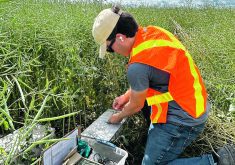Farmers and players in the grade trade aren’t the only ones looking forward to freer trade with Europe.
Canada’s eastern ports are al-ready banking on more goods flowing through their facilities once the Comprehensive Economic and Trade Agreement comes into effect.
However, port authorities have also inherited aging infrastructure and face a cavernous funding gap for rehabilitating and growing their infrastructure.
CETA holds potential for low protein wheat by promising to raise the current quota for tariff-free shipments to 100,000 tonnes from 38,000 tonnes and phasing out the limit completely after seven years.
Read Also

Feds propose overhaul of chronic wasting disease control program
Chronic Wasting disease control program getting updated by Canadian Food Inspection Agency with feedback encouraged from producers.
“As low protein wheat providers in Ontario, that’s something we’re really, really looking forward to,” said Nicole Mackellar, manager of market development with Grain Farmers of Ontario.
Other stories in this Special Report:
- ‘600 million opportunity’ awaits cattle sector
- Bison seen as biggest benefactor
- Doors may open but welcome mat takes time
- Dairy sector leery of EU trade
- Will EU trade reap benefits for all?
- Niche growers hope CETA will resolve GM issues
- CETA not silver bullet for European trade
- Port official follows motto: if you do it, do it right
- Navigating the trade waters
- Pork sector expects trade benefits
- Exporters must understand unique issues of EU buyers
Ontario corn already ships to Europe through the St. Lawrence Seaway, Mackellar said.
The EU is also Ontario’s largest soybean customer, taking one-third of the province’s crop.
Mackellar said CETA could assist with that trade by forming a working group to deal with biotechnology issues.
“To be able to continue to have free access and open access to that market is really critical and having those biotechnology traits ap-proved is really valuable,” she said.
Some think the trade deal could shift grain movement.
“I think there’s some opportunities to help even out the trade, maybe take some of the pressure off the logistics and transportation,” said Rex Newkirk, vice-president of research and innovation at the Canadian International Grains Institute.
The Port of Halifax is home to the last operating grain elevator on Canada’s Atlantic coast. Grain destined for Europe, the Middle East, and Africa is the elevator’s life blood.
The Halifax Grain Elevator is a network of 365 storage silos capable of loading 2,000 tonnes of wheat per hour.
It’s just one example of the kind of infrastructure needed to move grain overseas.
Patrick Bohan, director of supply chain solutions at the Halifax Port Authority, is excited about the role the elevator will play during the trade renaissance he’s expecting because of CETA.
He said trade between Halifax and European ports “is already pretty healthy … but it’s constrained by quotas and other restrictions.”
Bohan said the chatter around CETA focuses on agriculture and agri-food products.
Products from machinery to cranberries already roll through Halifax, and Prince Edward Island potatoes and soybeans set sail for Europe from the port. Seafood is “huge” in the area, and even lentils move through the port.
“There’s a long-established grain trade through here, including source-loaded containers off the Prairies that move to the East Coast by rail and then get on a ship and go over,” said Bohan.
Increasing trade with Europe plays well for the Port of Halifax. Bohan said it has intermodal service to move products quickly from the interior to port, and transit time at sea is pretty quick.
“And we’ve got the deepest water on the East Coast of North America here, so we’re getting container ships that can carry 9,000, 20-foot containers on board,” he said.
However, whether CETA will shift grain shipments to the east is another question.
Wendy Zatylny, president of the Association of Canadian Port Authorities, said it’s a difficult question to answer, given all the factors affecting how grain flows.
“So it’s not just the impact of CETA itself, but there’s also the capability of ports and shippers to handle the cargo,” she said.
“It’s a question of where rail can get the grain to quickly, and what’s the most efficient route?”
Zatylny said it’s hard to put a number on it, but all the ports are looking forward to CETA’s impact. They expect to export more agricultural goods and accept more container and bulk commodities from the EU.
All ports are developing European markets. Hamilton is positioning itself as a primary agricultural commodity port, she said.
The port has seen big investments in agriculture and food infrastructure in recent years, including a new P&H flour mill and G3’s new terminal. As well, agricultural cargo increased to two million tonnes from 815,000 tonnes between 2008 and 2014.
However, Canada’s ports also face a $5.3 billion infrastructure funding gap, Zatylny said. Speaking to a Senate committee last June, she suggested “innovative public-private partnerships” would be needed to close the gap.
The lion’s share of the $5.3 billion is needed for new projects to expand port capacity.
“They work on decades long planning cycles because that’s how long it takes for major infrastructure to be built,” she said.
Some ports still have physical space to expand, and those that don’t focus on efficiency.
Zatylny said one-third of the funding gap involves fixing aging infrastructure, such as berth facings and docks.
“There had been a history of underinvestment by the federal government over decades,.”
She said the St. Lawrence Seaway’s efficiency also needs to be looked at. The seaway was created to ship grain to Europe, and it remains a main shipping artery for agricultural exports. But margins are thin on the St. Lawrence, and a strategy is needed to make the system more competitive.
“It would be wonderful if we could make it year round, but even so, locks do need to close for maintenance,” said Zatylny.
“But even if we could extend the shipping season a little bit more on either end, through additional icebreaking capability, that sort of thing, it would be great.”
Zatylny said the Great Lakes and St. Lawrence Seaway should be seen as a system. For example, exporters will sometimes ship out of the Great Lakes and top up a ship in Three Rivers before hitting the open ocean.
“It’s more than just one port in Canada shipping to another port in the EU,” she said. “There’s actually a lot that happens within the system in Canada as well.”















